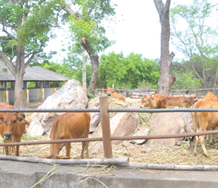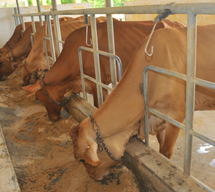Housing Methods
Loose Housing
- It is a system of housing in which animals are kept loose in an open paddock throughout the day and night except at the time of milking and treatment.
- In this system, shelter is provided along one side of open paddock under which animals can retire when it is very hot or cold or during rains.
- Common feed manger and water tank is provided and concentrates are fed at the milking time which is done in a separate milking barn or parlour in which cows are secured at milking time and are milked.
- The open paddock is enclosed by means of half walls or plain wire fences of convenient height.
|
 |
Advantages
- Cost of construction is cheaper.
- Future expansion is possible.
- The animals will move freely so that it will get sufficient exercise.
- The animal can be kept clean.
- Common feeding and watering arrangement is possible.
- Clean milk production is possible because the animals are milked in a separate milking barn.
- Oestrus detection is easy.
- At least 10-15 percent more stock than standard can be accommodated for shorter period.
Disadvantages
- It is not suitable for temperate Himalayan region and heavy rainfall areas.
- It requires more floor space.
- There is competition for feed.
- Attention of individual animal is not possible.
- A separate milking barn is needed for milking of animals.
Conventional Barns or Stanchion Barns
- In this system of housing, the animals are confined together on a platform and secured at neck by stanchions or neck chain.
- The animals are fed as wells as milked in the same barn.
- These barns are completely covered with roofs and the sidewalls are closed with windows or ventilator located at suitable places to get more ventilation and lighting.
- It is applicable for temperate and heavy rainfall region.
- The same type of housing can be utilized for tropical region with slight modification.
|
 |
Advantages
- The animals and men caring for animals are less exposed to harsh environment.
- The animals can be kept clean.
- Diseases are better controlled.
- Individual care can be given.
- Separate milking barn is not required.
Disadvantages
- Cost of construction is more.
- Future expansion is difficult.
- Not suitable for hot and humid climatic conditions.
Source : Tamil Nadu Veterinary and Animal Science University, Chennai
Updated on April 2015
|